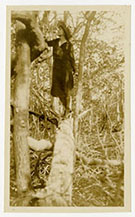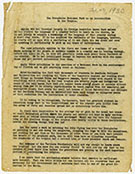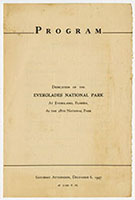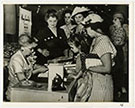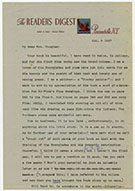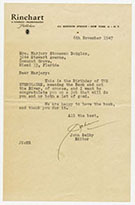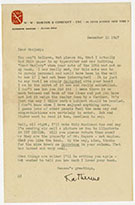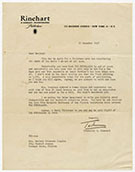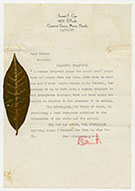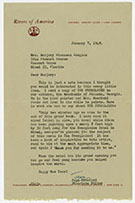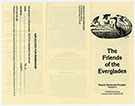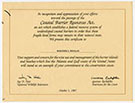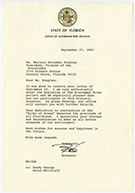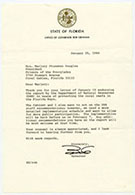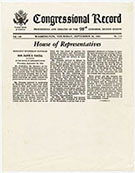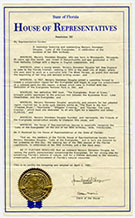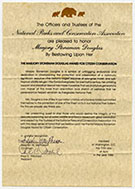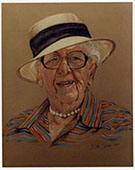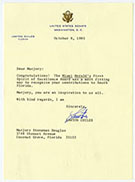Marjory Stoneman Douglas: Writer & Conservationist
River of Grass
The year 1947 marked the beginning of a period of significant changes. Marjory Stoneman Douglas published a very successful book: "The Everglades: River of Grass". The text significantly impacted the environmental history of Florida by redefining the Everglades as a source of free flowing fresh water essential to both the people and wildlife of the region. Marjory Stoneman Douglas was also present at the dedication of Everglades National Park by President Harry Truman on December 6, 1947. In "Voice of the River", Marjory recalled how Ernest Coe, like her father, had understood the importance of preserving the Everglades. Coconut Grove landscape architect, Ernest Coe served as the Chairman of the Tropic National Park Committee with David Fairchild as President. Marjory Stoneman Douglas and the Honorable Ruth Bryan Owen were the only two women on the Everglades Tropical Park Committee. Ruth Bryan Owen, the first elected congresswoman from Florida and later the first United States female ambassador, sponsored the bill.
During this time of her life Marjory Stoneman Douglas functioned as both an activist and writer. For example, she worked in 1948 on the board of the bi-racial Coconut Grove Slum Clearance Committee with Grove activists, Elizabeth Virrick and Reverend Gibson, the African American rector of Christ Church. The group lobbied for indoor plumbing for all residences in Dade County, including the segregated areas. The experience would elicit a book project with Elizabeth Virrick "Cities Against Slums" for which they applied for a Guggenheim Fellowship as well as an article published by Marjory Stoneman Douglas in a 1950 issue of Ladies Home Journal: "Communities Face Their Slums in Coconut Grove".
The 1950s and 60s were marked by a productive period of writing of books on Florida and its history. In 1951, Rinehart published "Road to the Sun", a fictional account of the South Florida 1920s boom. "Freedom River," published in 1952, centered on the adventures of three youths: "a white boy who was the son of a Quaker abolitionist family, a Miccosukee Indian boy, and an escaped slave" (Voice of the River, p. 203). A book about Florida history: "Florida the Long Frontier" was published in 1953. For her book "Hurricane" published in 1958, Marjory Stoneman Douglas traveled to North Carolina, Jamaica and Martinique. During those two decades, the author of "Everglades: River of Grass" also became known as a pivotal figure in environmental issues. She was awarded the Thomas Barbour Medal for Conservation by Fairchild Tropical Garden and the annual award of the International Oceanography Foundation. In 1969, an encounter with Joe Bowder of the National Audubon Society set Marjory Stoneman Douglas on an environmental crusade for the next 30 years of her life. In order to stop the construction of a jetport that would jeopardize the free flow of water in the Everglades, Marjory Stoneman Douglas founded "The Friends of the Everglades". She was 79.
Marjory Stoneman Douglas embarked on a string of speeches to various organizations and simultaneously recruited members and regional leaders for her growing organization that reached 3,000 people from various states. Their efforts were successful and the construction of the jet port never took place. As the founder and president of the Friends of the Everglades she continued to advocate for the preservation of "The Water" (Voice of the River, p. 228) and to recruit talents at water management conferences. The Friends of the Everglades fought for the cleaning up and preservation of the "Kissimmee-Okeechobee-Everglades basin" (Voice of the River, p. 231) on practical grounds. Marjory Stoneman Douglas stated that the preservation of fresh water was not a matter of environmental sentimentalism but was "the central support for our South Florida existence--the drinking water, all our water, all our rainfall. If the flow stops, it would mean the destruction of south Florida." (Voice of the River, p. 231)
While the Everglades remained a cherished concern, Marjory Stoneman Douglas became an advocate for all matters related to the preservation of the natural world. She was an active leader within the Florida environmental movement lending her support to the passage of various pieces of legislature and programs such as the "Coastal Barrier Resources Act (1982)" enacted for the effective management of barrier islands and beaches by limiting development. She lent her support to Governor Bob Grahams. "Save the Everglades" program (1983) while also endorsing a Department of Natural Resources (DNR) report for the protection of coral reefs (1984). As late as the 1990, when she was blind and facing health issues, Marjory Stoneman Douglas' "Friends of the Everglades" worked with other environmental groups to pass the "Dade County Referendum Environmental Preservation" plan to "establish a $90 million fund to buy and protect endangered land in Dade County". She received various honorary degrees and awards for her advocacy for the natural world. In 1993, Marjory Stoneman Douglas was awarded the Medal of Freedom by President Clinton.
On May 14, 1998 Marjory Stoneman Douglas died quietly at her home in Coconut Grove. She was 108 and had remained faithful to her belief that life should be lived intensely and vividly. Marjory Stoneman Douglas, engaged writer and conservationist, was a true friend of Florida and her Everglades.

